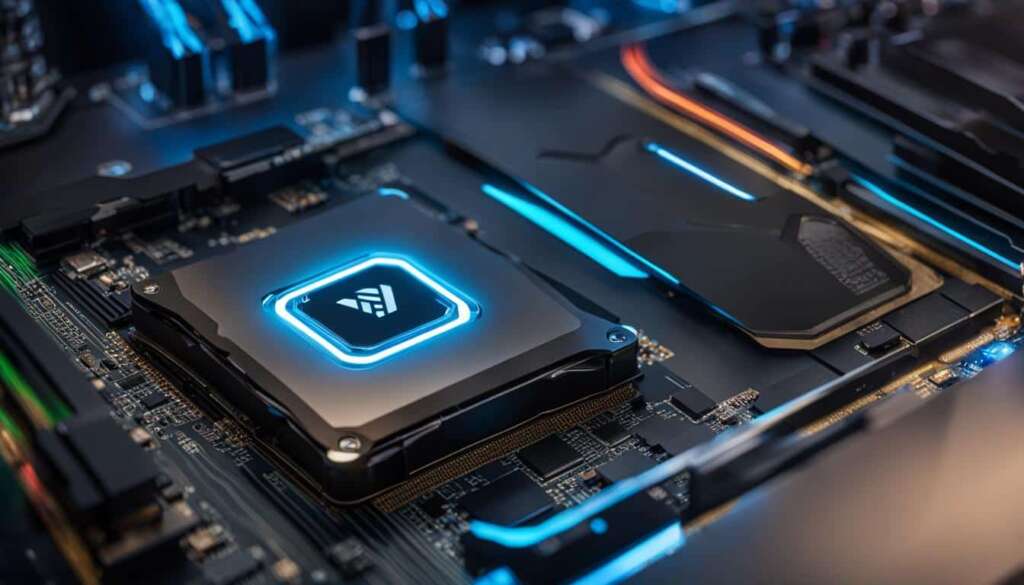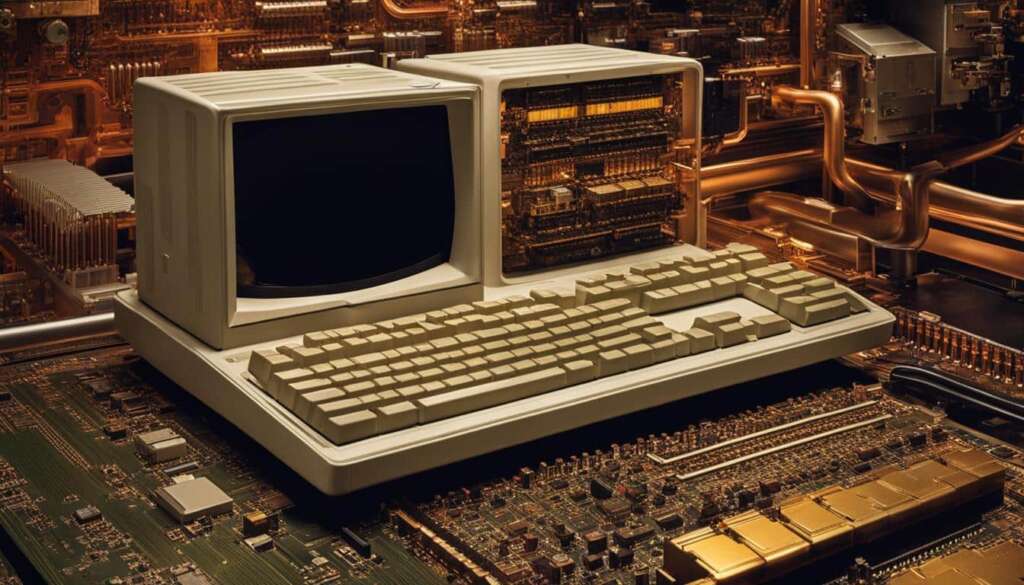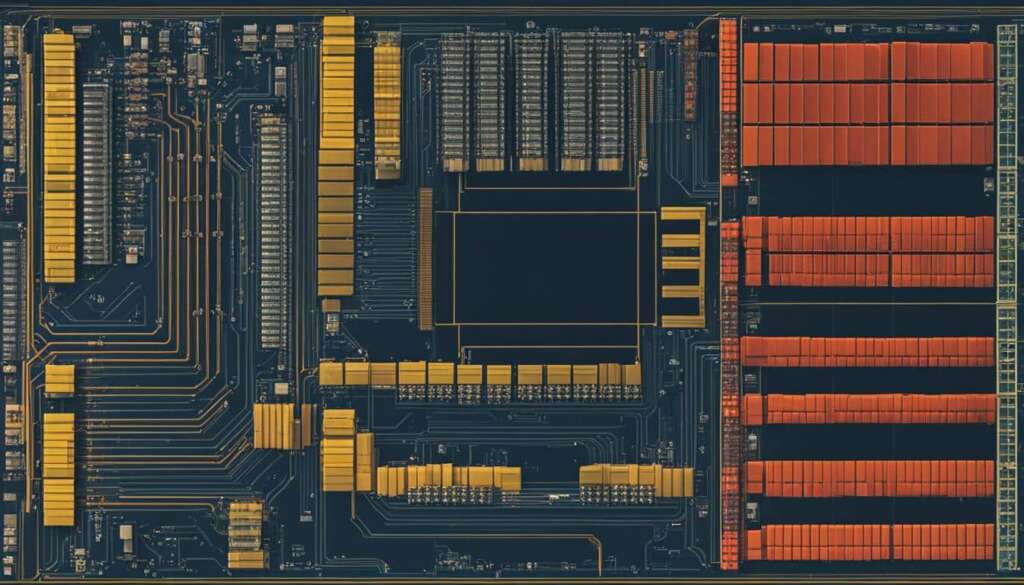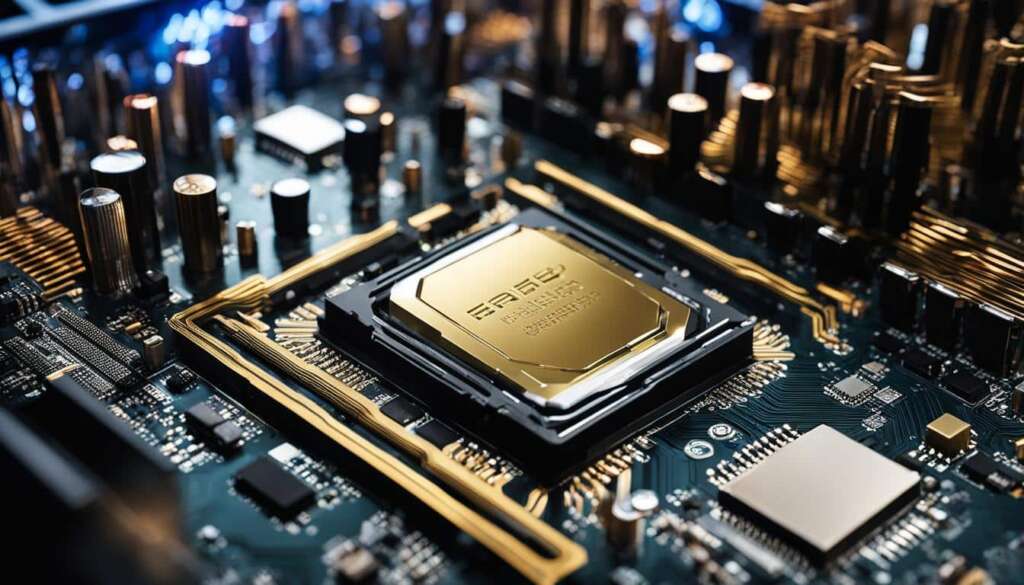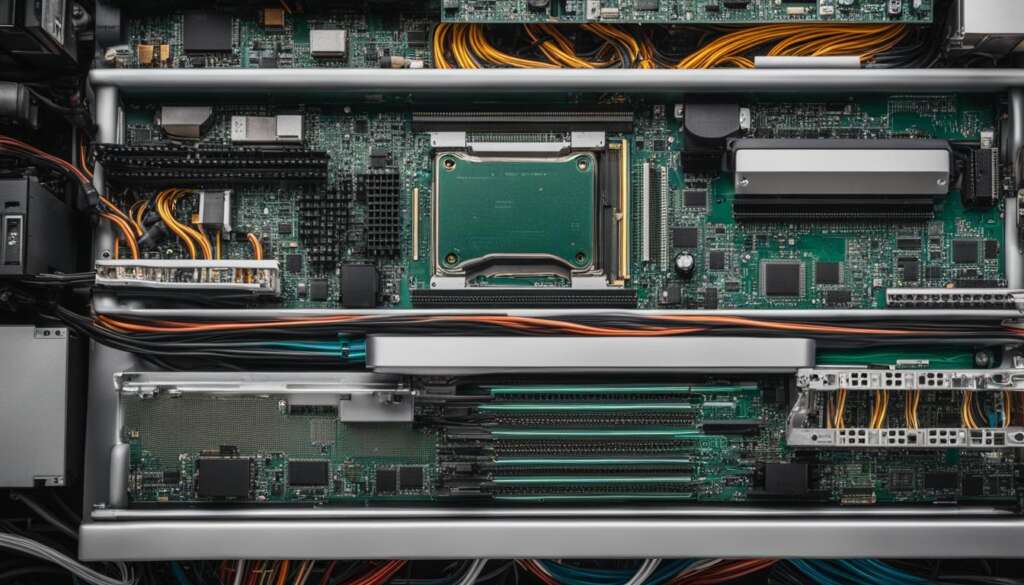Table of Contents
Processor benchmarking, CPU performance analysis, and processor speed testing are crucial aspects of evaluating the capabilities of computer hardware. In this article, we will delve into the fascinating history of benchmarking processors and explore its significance in today’s computing landscape.
Before we dive into the details, let’s briefly define benchmarking. It involves running tests and trials on computer hardware or software to assess their performance. Benchmarking allows for a fair comparison of different chip/system architectures, facilitating informed decision-making when it comes to selecting the best CPUs for specific tasks, such as gaming or scientific computing.
The evolution of CPU benchmarking has closely followed the advancements in computer architecture, adapting to the complexity of modern systems. Whether you’re a system builder, gamer, or professional requiring high-performance CPUs, understanding the benchmark results is essential in optimizing system performance and troubleshooting potential issues. Join us as we examine the purpose, types, challenges, and future trends in processor benchmarking.
Purpose of Benchmarking
The purpose of benchmarking is to compare and assess the performance of various computer systems or hardware components. It was developed to overcome the limitations of comparing systems based solely on their specifications. Benchmarking helps in making informed decisions on selecting the best CPU for gaming or other specific purposes. CPU benchmarking allows for evaluating the performance of processors in real-world scenarios, including gaming.
Benchmarking processors for gaming is crucial as gamers rely on their processors to deliver optimal gaming performance. Benchmarks can help gamers identify the best CPUs for gaming and make informed purchasing decisions. Gaming benchmarks focus on measuring a CPU’s performance in popular gaming titles and simulate real-world gaming scenarios. It is crucial to choose a CPU that can handle the demands of modern games and deliver smooth gameplay and high frame rates. Gaming-specific benchmarks can provide insights into a CPU’s performance in gaming workloads and help optimize gaming systems.
To gauge the performance of CPUs accurately, CPU benchmarking tools play a vital role. These tools help users assess the performance of their CPUs and compare them to other systems or processors in a standardized way. Some popular CPU benchmarking tools include SPEC (Standard Performance Evaluation Corporation), Geekbench, and PassMark. SPEC benchmarks are commonly used for measuring CPU and system performance and include a range of benchmarks for different applications and workloads. Geekbench is a cross-platform benchmarking tool that measures CPU and GPU performance, providing a comprehensive score for comparison. PassMark also provides detailed results and scores for various components, including CPUs.
In summary, the purpose of benchmarking is to compare and evaluate the performance of computer systems or hardware components. Benchmarking processors for gaming helps in selecting the best CPUs for optimal gaming performance. CPU benchmarking tools assist users in assessing the performance of their CPUs and comparing them to other systems or processors. Popular CPU benchmarking tools include SPEC, Geekbench, and PassMark. By utilizing these tools and benchmarks, users can make informed decisions when choosing CPUs for gaming or other specific purposes.
Types of Benchmarks
Benchmarking processors involves using different types of benchmarks to measure their performance under various workloads and scenarios. There are primarily two types of benchmarks used in CPU benchmarking: synthetic benchmarks and application benchmarks.
Synthetic benchmarks are specially designed programs that simulate specific workloads on a component or system. These benchmarks generate artificial workloads to stress test individual components like CPUs, allowing for a focused analysis of their performance. They often measure raw computational power and floating-point operations, providing insights into a CPU’s capabilities in different scenarios.
On the other hand, application benchmarks involve running real-world programs on the system to assess its performance in actual tasks. These benchmarks provide a more accurate representation of a CPU’s performance in real-world workloads, taking into account factors such as memory usage, caching, and multithreading efficiency. Application benchmarks are particularly useful for evaluating a CPU’s performance in specific applications or industries, such as gaming or scientific computing.
There are various benchmarking tools available to measure CPU performance, each with its own set of strengths and features. Some popular benchmarking software includes SPEC, Geekbench, and PassMark. These tools provide comprehensive benchmark results and scores that can be used to compare CPUs and assess their performance under different workloads. It is important to choose the most suitable benchmarking tool based on the specific requirements and goals of the benchmarking process.
Synthetic Benchmarks
| Benchmark | Description |
|---|---|
| 3DMark | A benchmark designed to assess the performance of a CPU and GPU under gaming workloads. It includes various graphical and physics tests to evaluate the system’s gaming capabilities. |
| SuperPi | A benchmark that calculates the value of pi to a specific number of digits. It measures a CPU’s single-threaded performance and its ability to perform complex mathematical calculations. |
| Cinebench | A benchmark that focuses on CPU and GPU performance in cinema 4D applications. It tests a CPU’s ability to render complex 3D scenes and produces scores that can be used to compare CPUs. |
Application Benchmarks
| Benchmark | Description |
|---|---|
| PCMark | A benchmark that measures a CPU’s performance in various real-world scenarios, including web browsing, video conferencing, and document editing. It provides scores that reflect a CPU’s overall performance in everyday tasks. |
| PassMark PerformanceTest | A benchmark that assesses a CPU’s performance in different aspects, such as CPU, memory, disk, and graphics. It provides detailed scores and results for each component, allowing for a comprehensive analysis of system performance. |
| Blender Benchmark | A benchmark that focuses on CPU performance in Blender, a popular 3D modeling and rendering software. It measures a CPU’s ability to handle complex rendering tasks and provides scores that can be used for comparison. |
Importance of CPU Benchmarking
CPU benchmarking is a critical tool for assessing the performance of processors and making informed decisions when comparing different options. Whether you are a system builder, gamer, or professional in a demanding field, benchmarking provides valuable insights into the capabilities of CPUs and helps determine the best processor for your specific needs.
One of the key advantages of CPU benchmarking is that it allows for a fair and standardized comparison of different processors. By running tests and trials on various CPUs, benchmarking tools provide an objective measure of performance, enabling users to make informed decisions based on real-world data. This helps avoid relying solely on manufacturers’ specifications, which may not accurately reflect actual performance in different scenarios.
With CPU benchmarking, you can assess the performance capabilities of a processor under specific workloads and identify any potential bottlenecks. This is particularly important for tasks that require high-performance computing, such as gaming, video editing, or scientific computing. By benchmarking different CPUs, you can determine which processor is best suited for your specific requirements and optimize your system accordingly.
How to Benchmark a CPU
Benchmarking a CPU involves running tests and trials on the processor to evaluate its performance. Here are the steps to benchmark a CPU:
- Select a reliable CPU benchmarking tool: There are several benchmarking tools available, such as SPEC, Geekbench, and PassMark. Choose a tool that is well-regarded and suits your specific needs.
- Follow the instructions provided by the benchmarking tool: Each tool has its own set of instructions and procedures for benchmarking CPUs. Make sure to carefully read and follow these instructions to ensure accurate results.
- Run the benchmarking tests: The benchmarking tool will run a series of tests on your CPU, measuring its performance under different workloads and scenarios. These tests may include tasks such as rendering graphics, encoding videos, or performing complex calculations.
- Analyze the benchmark results: Once the benchmarking tests are complete, you will be presented with detailed results that indicate the CPU’s performance in various areas. Pay attention to metrics such as multi-threaded performance, single-threaded performance, and overall benchmark scores.
- Compare and make informed decisions: Use the benchmark results to compare the performance of different CPUs and make informed decisions when selecting a processor for your specific needs. Consider factors such as gaming performance, multi-threaded capabilities, power efficiency, and budget.
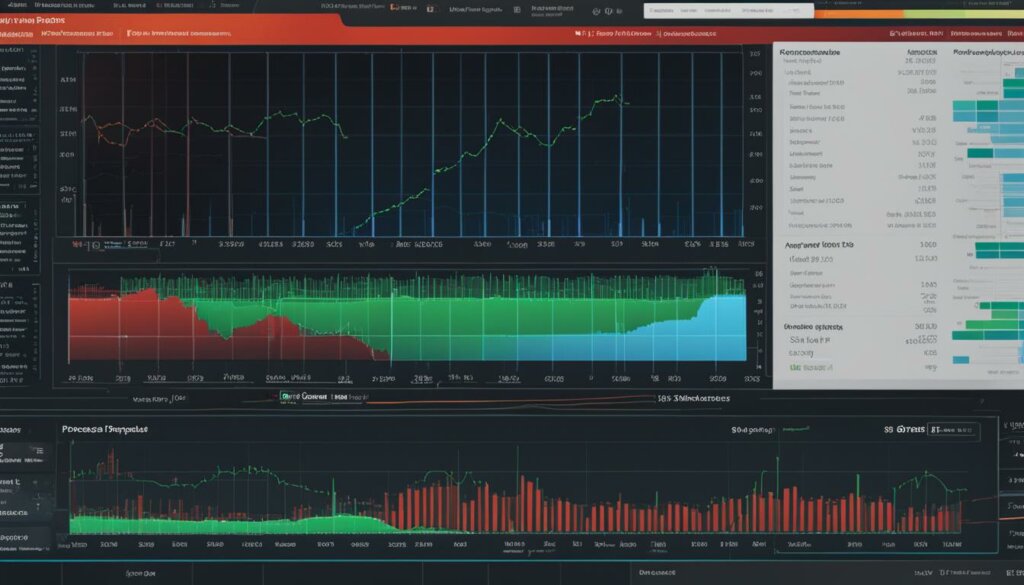
The Challenges of Benchmarking Processors
When it comes to benchmarking processors, there are several challenges that need to be considered. Vendors often tune their products specifically for industry-standard benchmarks, which may not reflect real-world performance. Additionally, some benchmarks focus solely on computational speed and fail to consider other important aspects of a system. Furthermore, benchmarks do not take into account factors such as the total cost of ownership or the qualities of service. It’s also important to note that different users may have different perceptions of performance, and benchmarks may not always align with their expectations.
One of the key challenges in benchmarking processors is comparing CPUs with different architectures. CPUs with many execution units may have slower clock rates but can outperform high-clock-rate CPUs in real-world scenarios, both in terms of performance and benchmark scores. While benchmarks provide valuable insights, they should not be the sole factor in decision-making. It’s essential to consider other factors such as workload requirements and specific use cases when selecting a processor.
To overcome these challenges, it’s crucial to use the best processor benchmark software available. There are several popular benchmarking tools that provide detailed results and scores, allowing users to compare processors in a standardized way. These tools help assess the performance of CPUs, taking into account factors such as single-threaded and multi-threaded performance. By analyzing benchmark results and considering real-world performance requirements, users can make informed decisions when selecting the right CPU for their needs.
| Challenges in Benchmarking Processors | Solutions and Considerations |
|---|---|
| Vendors tune products for industry-standard benchmarks | Look beyond benchmarks and consider real-world performance and user requirements |
| Some benchmarks focus solely on computational speed | Consider other important aspects of a system, such as power efficiency and memory performance |
| Benchmarks do not consider total cost of ownership or qualities of service | Assess the overall value and long-term implications of a processor beyond benchmark scores |
| Different users may have different perceptions of performance | Consider individual workload requirements and user expectations when selecting a processor |
Popular CPU Benchmarking Tools
When it comes to benchmarking your CPU, there are several popular tools available that can help you assess its performance and compare it to other systems or processors in a standardized way. These tools provide valuable insights for both casual users and professionals who rely on high-performance CPUs.
“SPEC (Standard Performance Evaluation Corporation) benchmarks are commonly used for measuring CPU and system performance. They include a range of benchmarks for different applications and workloads. Geekbench is a cross-platform benchmarking tool that measures CPU and GPU performance. It provides a comprehensive score that can be used to compare CPUs across different systems. PassMark is another popular benchmarking tool that provides detailed results and scores for various components, including CPUs.”
With these tools, you can assess the overall performance of your CPU by looking at benchmark scores and specific metrics such as single-threaded and multi-threaded performance. This allows you to understand your CPU’s capabilities in different scenarios and compare it to other processors. Whether you’re a gamer, a system builder, or a professional working with CPU-intensive tasks, these tools can help you make informed decisions and optimize your system performance.
| Benchmarking Tool | Features |
|---|---|
| SPEC | Measures CPU and system performance with different benchmarks for various applications and workloads. |
| Geekbench | Measures CPU and GPU performance, providing a comprehensive score for cross-system CPU comparisons. |
| PassMark | Provides detailed results and scores for various components, including CPUs. |
These benchmarking tools offer a standardized way to evaluate CPU performance and compare different systems. They are constantly evolving to keep up with advancements in technology and computing needs. With the help of these tools, you can make informed decisions when selecting the best CPU for your specific requirements and ensure optimal system performance.

Benchmarking Processors for Gaming: CPU Performance Analysis
When it comes to gaming, CPU performance is crucial for delivering optimal gameplay and smooth gaming experiences. Benchmarks play a vital role in helping gamers identify the best processors for gaming and make informed purchasing decisions. By analyzing CPU performance through benchmarking, gamers can ensure that their systems are equipped to handle the demands of modern games and deliver high frame rates.
“Benchmarking processors for gaming allows gamers to assess the performance capabilities of different CPUs and choose the best one for their gaming needs.”
Gaming-specific benchmarks focus on measuring a CPU’s performance in popular gaming titles and simulate real-world gaming scenarios. These benchmarks provide insights into how a CPU handles gaming workloads, including tasks such as rendering graphics, physics calculations, and AI processing. By comparing benchmark results across different processors, gamers can identify the CPUs that excel in gaming performance.
The Importance of CPU Performance Analysis for Gaming
CPU performance analysis is crucial for gamers who rely on their processors to deliver exceptional gaming experiences. By benchmarking processors, gamers can:
- Identify the best CPUs for gaming
- Make informed purchasing decisions
- Optimize gaming systems for smooth gameplay and high frame rates
By assessing CPU performance in gaming scenarios, gamers can ensure that their systems are capable of handling the requirements of modern games. This includes not only the CPU’s raw processing power but also its ability to handle complex graphics and AI tasks. In an industry where every frame counts, CPU benchmarking provides gamers with the insights they need to build powerful gaming rigs that deliver exceptional gaming performance.
| CPU Benchmarking for Gaming | Benefits |
|---|---|
| Allows gamers to assess the performance capabilities of different CPUs | Ensures informed decision making when purchasing a CPU |
| Helps optimize gaming systems for smooth gameplay and high frame rates | Identifies the best CPUs for gaming |
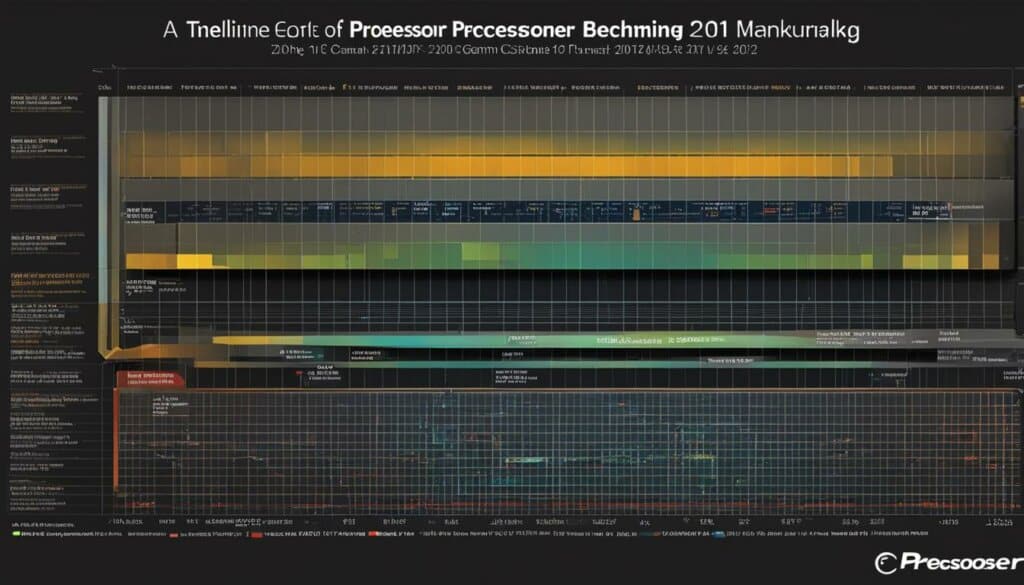
In conclusion, CPU benchmarking for gaming is an essential process that allows gamers to evaluate the performance capabilities of different processors. By analyzing CPU performance in gaming scenarios, gamers can make informed decisions when purchasing CPUs and optimize their gaming systems for exceptional gameplay experiences. With the ever-increasing demands of modern games, CPU benchmarking provides gamers with valuable insights into choosing the best processors for gaming.
Analyzing Processor Benchmark Results
When it comes to analyzing processor benchmark results, there are several important factors to consider. By examining these metrics, you can gain insights into the performance and capabilities of a CPU.
Overall Benchmark Score
First and foremost, it’s crucial to look at the overall benchmark score of a CPU. This score allows you to compare the relative performance of different processors. A higher score indicates better performance, while a lower score suggests lower performance.
Single-Threaded and Multi-Threaded Performance
Another critical metric to consider is the single-threaded and multi-threaded performance of a CPU. Single-threaded performance refers to how well a processor performs tasks that can only be executed by a single core. Multi-threaded performance, on the other hand, measures a CPU’s ability to handle tasks that can be distributed across multiple cores.
Comparison Across Different Systems and Architectures
It’s also important to compare benchmark results across different systems and architectures. This allows you to gain a broader perspective on a CPU’s performance. Keep in mind that different architectures may prioritize different aspects, such as power efficiency or computational power, which can impact benchmark results.
Consider the Specific Workload or Task
Lastly, when analyzing benchmark results, consider the specific workload or task for which the CPU is being benchmarked. Different tasks may have varying requirements, and a CPU’s performance in one area may not necessarily translate to optimal performance in another. Therefore, it’s crucial to assess the CPU’s performance in the context of the intended use.
By carefully analyzing these processor benchmark results, users can make informed decisions when selecting a CPU that meets their specific needs and requirements.
| Processor | Overall Benchmark Score | Single-Threaded Performance | Multi-Threaded Performance |
|---|---|---|---|
| Processor A | 1500 | 80 | 450 |
| Processor B | 1800 | 95 | 550 |
| Processor C | 1200 | 70 | 400 |
Future Trends in Processor Benchmarking
Processor benchmarking is a dynamic field that continues to evolve alongside advancements in technology and the ever-growing demands of computing. As new generations of CPUs are released, benchmarking tools and methodologies are being refined to accurately measure their performance and capabilities. Future trends in processor benchmarking are likely to focus on several key areas.
One of the prominent trends in CPU benchmarking is the increasing emphasis on power efficiency. With the growing concern for energy consumption and sustainability, measuring the performance-per-watt ratio of CPUs will become crucial. Benchmarking tools will not only assess raw computational power but also factor in power efficiency metrics, enabling users to make informed decisions about their processors’ energy efficiency.
Another important trend is the inclusion of advanced workload simulations in benchmarking methodologies. As computing workloads become more diverse and complex, benchmarking tools will strive to replicate real-world scenarios more accurately. This means considering factors such as cache hierarchy, memory performance, and multi-threading efficiency to provide a comprehensive assessment of a CPU’s performance in practical applications.
Furthermore, as artificial intelligence (AI) continues to advance, benchmarking tools will likely incorporate metrics specifically designed to measure AI performance. AI workloads place unique demands on CPUs, requiring high-speed parallel processing and efficient handling of large datasets. Future benchmarking methodologies will aim to evaluate CPUs based on their AI capabilities, providing valuable insights for AI researchers, developers, and users.
| Trend | Description |
|---|---|
| Power Efficiency | Benchmarking tools will focus on measuring the performance-per-watt ratio of CPUs, considering energy consumption and sustainability. |
| Advanced Workload Simulations | Benchmarking methodologies will replicate real-world scenarios more accurately, incorporating factors like cache hierarchy, memory performance, and multi-threading efficiency. |
| AI Performance | Benchmarking tools will incorporate metrics to assess CPUs’ capabilities in handling AI workloads, providing insights for AI researchers and developers. |
Conclusion
Benchmarking processors plays a critical role in assessing and comparing the performance of CPUs under different workloads. It provides valuable insights for system builders, gamers, and professionals who rely on high-performance CPUs.
Choosing the right CPU for specific tasks requires understanding benchmark results and considering factors such as gaming performance, multi-threaded capabilities, and power efficiency. CPU benchmarking tools help users make informed decisions and optimize system performance based on their specific needs.
The future of processor benchmarking will continue to evolve alongside advancements in CPU technology, providing more accurate measurements and insights into CPU performance. As new generations of CPUs are released, benchmarking tools and methodologies will adapt to accurately measure their performance. Future trends in processor benchmarking may include more focus on power efficiency, AI performance, and advanced workload simulations.
FAQ
What is benchmarking?
Benchmarking is the act of running tests and trials on computer hardware or software to assess its performance.
What is the purpose of benchmarking processors?
The purpose of benchmarking is to compare and assess the performance of various computer systems or hardware components.
How does CPU benchmarking help in selecting the best processor?
CPU benchmarking allows for evaluating the performance of processors in real-world scenarios, including gaming, and helps in making informed decisions on selecting the best CPU for specific purposes.
What are the types of benchmarks?
There are two main types of benchmarks: synthetic benchmarks and application benchmarks.
Which benchmarking tools are available for measuring CPU performance?
Some popular benchmarking tools for measuring CPU performance are SPEC, Geekbench, and PassMark.
Why is CPU benchmarking important for gamers?
CPU benchmarking is particularly important for gamers as it helps identify the best CPUs for gaming and make informed purchasing decisions.
How should processor benchmark results be analyzed?
When analyzing processor benchmark results, factors such as overall benchmark score, specific metrics like single-threaded and multi-threaded performance, and comparison across different systems and architectures should be considered.
What are the challenges in benchmarking processors?
Some challenges in benchmarking processors include vendors tuning products for industry-standard benchmarks, neglecting other important features, and different users having different perceptions of performance.
What are the future trends in processor benchmarking?
Future trends in processor benchmarking may include more focus on power efficiency, AI performance, and advanced workload simulations.
How does benchmarking contribute to assessing and comparing CPU performance?
Benchmarking processors plays a critical role in assessing and comparing the performance of CPUs under different workloads, providing valuable insights for system builders, gamers, and professionals.

